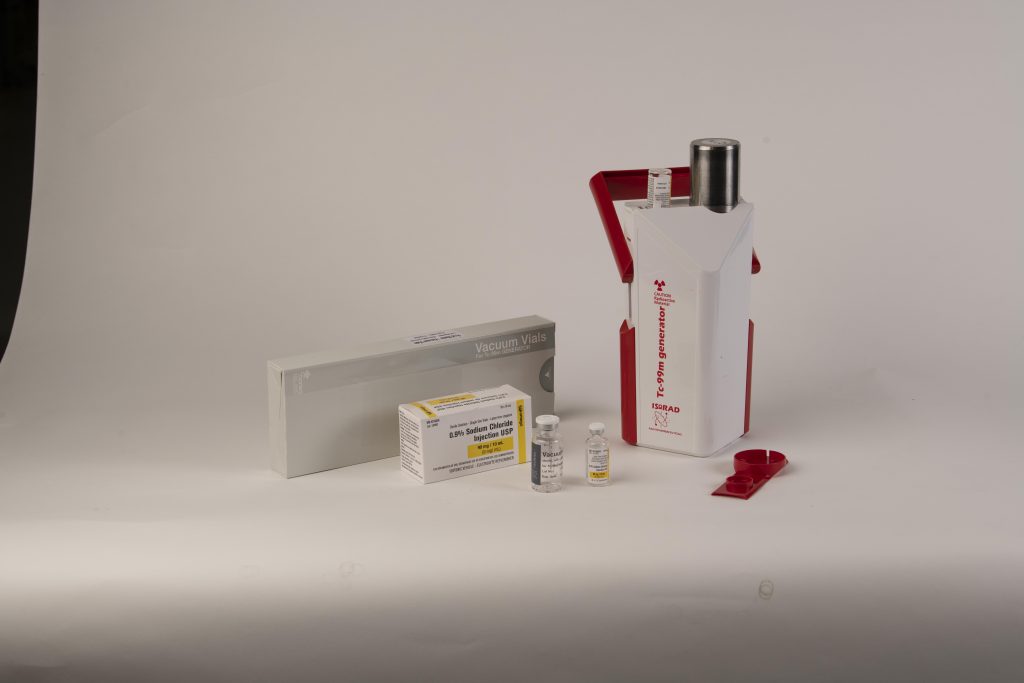This is a device used to extract the isotope Tc99m from decaying molybdenum-99. The Tc99m is used for a variety of nuclear medicine diagnostics in single photon emission computed tomography (SPECT) procedures, where its short half-life of a few hours is all that is needed. Utilizing dry technology, sterile Technetium-99m generators have been manufactured in Israel since 1976. They are ergonomic, safe (with built-in radiation shielding) and easy to use by hospital personnel and are recyclable.


Thallium-201 (201Tl) is a radioactive potassium analog used in the diagnosis of coronary artery disease and parathyroid hyperactivity using single photon emission computed tomography (SPECT). Sterile 201Tl has been manufactured by Isorad since 1987.

Gallium-67 (67Ga) is a cyclotron-produced radio metal used by single photon emission computed tomography (SPECT) imaging for localization of inflammatory lesions (infections). With 67Ga you can obtain images of a specific type or the diseased state of tissue. Sterile 67Ga has been manufactured by Isorad since 1987.
FDG (fluorodeoxyglucose) is used to detect metabolically active malignant lesions of lung, colorectal and breast cancers , as well as lymphoma,melanoma, and others. It may also be used to stage and monitor the response to malignant disease therapy.
18F-DOPA (18F-dihydroxyphenylalanine) is used to measure the uptake of dopamine precursor for assessment of presynaptic dopaminergic integrity and can be a useful tool for the detection of different neuroendocrine tumors NETs). It has greater sensitivity as compared to somatostatin receptor scintigraphy, and has been historically used for the evaluation of Parkinsonian syndromes in research settings. With the wider availability of PET cameras, this method can be used as a clinical diagnostic tool.
Both F18 and Ga18 preparations are used for detecting suspected prostate cancer in patients and for evaluating proper treatment.
18F-DOPA (18F-dihydroxyphenylalanine) is used to measure the uptake of dopamine precursor for assessment of presynaptic dopaminergic integrity and can be a useful tool for the detection of different neuroendocrine tumors (NETs). It has greater sensitivity as compared to somatostatin receptor scintigraphy, and has been historically used for the evaluation of Parkinsonian syndromes in research settings. With the wider availability of PET cameras, this method can be used as a clinical diagnostic tool.
FDG (fluorodeoxyglucose) is used to detect metabolically active malignant lesions of lung, colorectal and breast cancers, as well as lymphoma, melanoma, and others. It may also be used to stage and monitor the response to malignant disease therapy.
Both F18 and Ga18 preparations are used for detecting suspected prostate cancer in patients and for evaluating proper treatment.
Ga-68 Dotatate is used during PET scanning for localization of somatostatin receptor positive neuroendocrine tumors. The Ga-68 Dotatate PET/CT scan also allows whole-body imaging of cell surface expression of somatostatin receptors (SSTRs) and is rapidly evolving as the new imaging standard of reference for the detection and characterization of NETs (neuroendocrine tumors).
Both Ga-68 and F-18 preparations are used for detecting suspected prostate cancer in patients and for evaluating proper treatment.
Tc-99m MDP 99mTc-methylene diphosphonate
Tc-99m MDP 99mTc-methylene diphosphonate is a USA FDA-approved radioactive agent widely used for bone scintigraphy. It is used as a skeletal imaging agent, demonstrating areas of osteogenesis imperfecta, e.g., in metastatic bone disease, Paget’s disease, arthritis disease and osteomyelitis.


Tc-99m Sulfur Colloid
Technetium Tc-99m sulfur colloid is a gamma-emitting colloid used in scintillation scanning of the reticuloendothelial system (RES), producing images of functioning reticuloendothelial cells in the liver, spleen and bone marrow. These can assist in studying esophageal transit, gastro esophageal reflux, as well as detection of pulmonary aspiration of gastric content. Tc-99m sulfur colloid is also used in peritoneovenous shunt scintigraphy for assessing shunt patency in adults.

Tc-99m Filter Sulfur Colloid
Tc-99m Filter Sulfur Colloid is used for localization of sentinal lymph nodes (SLNs) in draining of a primary tumor, in patients with breast cancer or malignant melanoma . The filter sulfur colloid preparation shows improved discrimination between SLNs and secondary lymph nodes on lymphoscintigraphy, relative to the sulfur colloid preparation.
Tc-99m-Cardiolite (Sestamibi)
Tc-99m Cardiolite is the most common agent used for performing myocardial perfusion scintigraphy. It detects Coronary artery disease by localizing Myocardial Ischemia and infarction, and assists in presenting better-informed evaluations for patient management decision making.


Tc-99m-DMSA
Tc-99m DMSA (2,3 dimercaptosuccinic acid) is used in static planar and tomographic renal imaging to evaluate renal structure and morphology, particularly in pediatric imaging for detection of scarring and pyelonephritis.

Tc-99m – Mag3
Tc-99m Mag3 (mercaptoacetyltriglycine) is another technetium radiopharmaceutical used in renal imaging. Due to favorable energy and dosimetric characteristics, Mag3 radiolabeled with technetium has replaced the iodide-131 Hippuran for the study of renal function (tubular secretion physiology). It is used for dynamic renal study in adults as well as in children.

Tc-99m – DTPA
Tc-99m DTPA (diethylene-triamine-pentaacetate) is also used in renal imaging and primarily used to measure the glomerular filtration rate (GFR). Tc-99m DTPA has been utilized as a radiotracer, when conjugated to tissue specific molecules, in a wide variety of nuclear imaging studies, including brain, lung, and renal function studies.

Tc-99m-MAA
Tc-99m MAA (macroaggregated albumin) is used in lung perfusion imaging. It is part of the study in the evaluation of pulmonary thromboembolism, and consists of a sterile aqueous suspension of Technetium-99m labeled to human albumin aggregate particles.